
02 Nov TIO Peru: Cusco + Sacred Valley & Sol y Luna
Cusco today is the cultural capital of Peru, but its importance goes way back in time.
As the oldest living city in the Americas, Cusco has been inhabited continuously for over 3,000 years. It was, in fact, capital of the Inca Empire from the 13th to 16th century until the Spanish invasion of 1533. In 1534, Pizzaro claimed Cusco for the Spanish King. Today it is a major tourist destination, receiving nearly two million visitors per year – including us.
Between Cusco and Machu Picchu, lies the Sacred Valley of the Incas, which has remained largely untouched by time, its villages and ancient ruins still dotting the landscape of wide open fields and steep mountain slopes. The place pulses with Andean history and culture – with some contemporary add-ons in the mix.
However, a brief pause before we talk about what we did and what we saw in Cusco and the Sacred Valley for a coda to Clint Viebrock’s in-depth story about the Amazon (and Machu Picchu).
Coda, the Peruvian Amazon under threat:

Peruvian Amazon from one of the Reserva’s decks.
Back in the 1990s, an ethnobotanist named Mark Plotkin presented at Mountainfilm. His subject? The Amazon rainforest.
The Amazon is, as we know, one the most important resources on earth in part because it helps maintain the earth’s water cycle by producing large quantities of rainfall annually.
The Amazon also helps to slow global warming by fixing carbon dioxide and producing 20 percent of the world’s oxygen in the process.
The rainforest is also home to a variety of vegetation that makes powerful medicines. On one of our walks during our stay in the jungle, our guide Paolo at the lux eco-resort of Inkaterra Reserva Amazonica pointed out trees and plants that help prevent or cure maladies, major and minor, ranging from diabetes to prostate cancer, impotence, stomach pain and mosquitos bites.
For some time now, all that has been under siege, now potentially made worse by the election of a far-right president in Brazil, a threat (like you know who) that challenges global warming and will support big business interests over preservation.
In Peru, business interests like logging, gold, oil, are already an issue, but perhaps the darkest challenge comes from inside.
Paolo told us that 55 percent of the population of nearby Puerto Maldonado conspires in illegal gold mining in the waters surrounding the forest. One of the elements involved in processing gold is mercury, a toxic heavy metal. Mercury is polluting the water and poisoning fish, a big part of the local diet. When asked if there was anything to be done about the problem, the answer was sadly “no.”
We were told the problem dates back to the time of the Spanish conquest. The Spanish effectively enslaved Peru’s indigenous people, who worked for nearly nothing – so they found workarounds. One of the strategies involved secreting away gold, wherever they could find it, for a rainy day. With the rainy season around the corner, locals in Puerto Maldonado are simply continuing that centuries-old tradition.
Why am I telling you all this? Because when traveling to Peru, getting to the Amazon sooner rather than later might be a good idea. Also supporting Plotkin’s Amazon Conservation Trust, which now works primarily in Colombia and Brazil, but in our opinion should add Peru to its list. Established in 1996, the mission of that nonprofit is to mitigate challenges to the rainforests and its water. And progress has been made. It turns out that money talks. And when large swaths of land, such as the thousands of acres surrounding Inkaterra, are officially put in trust, for the most part the crooks stay away.
Cusco & The Sacred Valley:
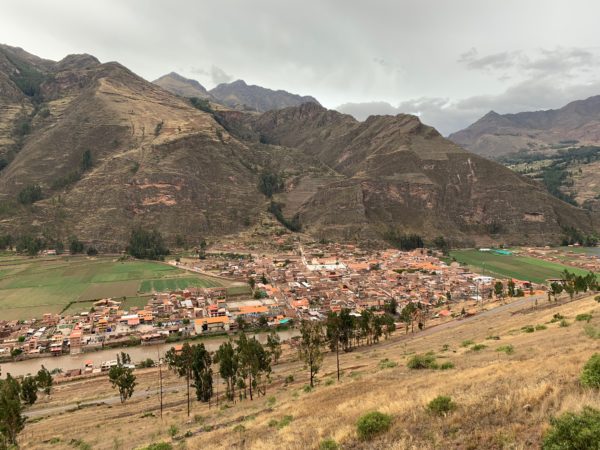
Sacred Valley, Peru
En route to the Sacred Valley, we stopped to stretch our legs in the village of Awana Kancha. In the Quehcua language of the ancient Incas – and still spoken by about eight million people in Peru, Bolivia, Ecuador, Colombia and Argentina – the name breaks down to “weaving” (Awana) and “worshipping” (Kancha). The small farm is home to a furry herd of South American camelids (llamas, alpacas, and vicuna). In the textile showroom, local artisans demonstrate traditional weaving techniques, producing colorful garments right before your eyes.
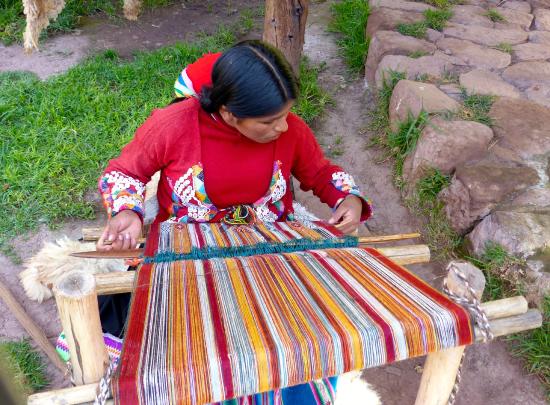
From there we passed through the town of Pisac, gateway to the Sacred Valley and then it was on to Ollantaytambo, a picturesque town with cobbled streets and dotted with quaint cafes.

Ollantaytambo
Ollyantaytambo was once a military, religious, administrative and agricultural complex. And it is the only Inca town that remains almost intact. Houses still serve as homes where descendants of the Incas live.
Ollantaytambo features yet another stunning ancient Inca complex of stone terraces, including a walled fortress, hilltop storehouses, and a never-completed Sun Temple. Once used as a royal residence by Emperor Pachacuti, the temple and fortress are of extremely high quality and should be on anyone list of places to visit in the Valley. The main temple has a front with six monoliths of pink granite brought from elsewhere and assembled perfectly on the stone.

Ruins at Ollantaytambo
As our guide explained Pachacuti Inca Yupanqui (often simply Pachacuti or Pachacutec) was the 9th Inca ruler (r. 1438 – 1471) who expanded their empire with conquests in what was then known as the Cuzco Valley and beyond.
Pachacuti, our guide Mariela explained is credited with founding the site of Machu Picchu. His title “Pachacuti,” which he purportedly gave himself on his accession, means “Reverser of the World” or ‘”Earth-shaker.” The same word was used by the Incas to refer to the epoch-changing event or “turning over of time and space,” which they believed occurred regularly through the arc of history.
Another of our guides told us Hiram Bingham, the man who discovered Machu Picchu beneath the forest growth in 1911 – it had been abandoned in 1536 – described Pachacuti as the Alexander the Great of his culture: “The Man Who Changed the World.” An appropriate enough handle for a ruler who set his people on the road to prosperity and created an empire which would eventually be the largest ever seen in the Americas.
We were also meant to visit the Huiloc communities, a drive of about an hour up a narrow dirt road from Ollantaytambo, which sit about 3,500 meters or about 11,500 feet above sea level. The locals there continue to weave a range of textiles in the tradition of their ancestors. And in their textiles, they depict images of the world in which they live, including the flora and fauna of the place. Like almost all descendants of indigenous people in the country, the Huilocs honor Pachamama or Mother Earth through their arts and crafts.
However, just ahead of our car, a truck carrying heavy equipment had failed to make a hairpin turn, crashed and dropped its load on the narrow road – upending our plans too.
Towards the end of the trip, on our second stop in and around Cusco, we saw other Incan sites such as Sacsayhuaman, which features buildings fashioned from limestone, one of the hardest rocks on earth. Pachacuti had redesigned the city to give its boundaries the form of a reclining puma, with its head in Sacsayhuaman.

The stone walls of Sacsayhuaman
The guess is that the underground tunnels, amphitheaters, and ritual constructions at Sacsayhuaman related to the worship of water. The site clearly played a major role in Incan ritual activities. It is where the annual festival of the Inti Raymi takes place, the Inca ritual of worshipping the God Sun or “Inti.” Visitors come from around the world to witness the celebration.
Another stop of Quenko, which is actually two sites, the Great and the Small. That center is dedicated to the the worship of the Sun/Emperor and is of particular interest for its semi-circular amphitheater and underground galleries.
Tambomchay is known for its canals and waterfalls, a tip of the hat to Incan architects and the culture’s highly advanced hydraulic engineers.
With its watch tower, Puka Pukara is the site of a military ruin that was part of the defense of Cusco in particular and the Incan Empire in general.
Basilica Cathedral of Cusco:
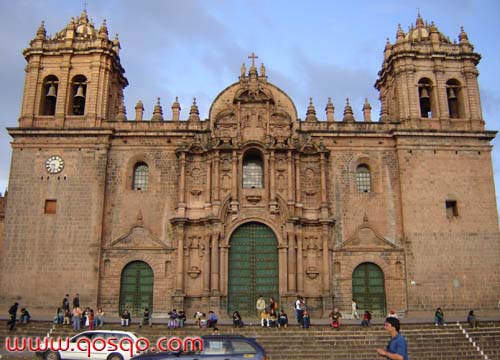
It’s the same old story. The invading Spanish sought to wipe out any signs of the indigenous cultures, especially Incan, and plaster them over, literally and metaphorically, as I stated in an earlier post,
The structure – at least the smaller church on the right side of the main building – was built using blocks pilfered from the nearby Inca site of the aforementioned Sacsayhuaman and it sits on the bones of an Incan palace, a place to worship the Sun and the Sun King or Incan ruler. (Inca means king.) The so-called Triunfo (Church of Triumph) was put up after the Inca uprising and siege of 1536.
Construction on the basilica was started around 1654. Once completed, after 100 years of labor, the overall structure, a massive, glitzy, gilded edifice, is a hodgepodge of Gothic, Renaissance Mannerist and Baroque architecture. Now the “mother church” of the Roman Catholic Church of the Archdiocese of Cusco, the Cusco Cathedral was designated a UNESCO World Heritage Site in 1983.
Among its many eccentricities is the church’s version of “Last Supper,” painted by Cusco master Marcos Zapata.
Zapata replaced the traditional main course of lamb with a Viszacha, a wild Andean chincilla (not a guinea pig and many think). According to Andean myths, the chincilla was the spiritual guardian of lakes and mountains. A window behind the Christ figure depicts a sky full of stars, including a shooting star. (Hard to miss the metaphor, no?)
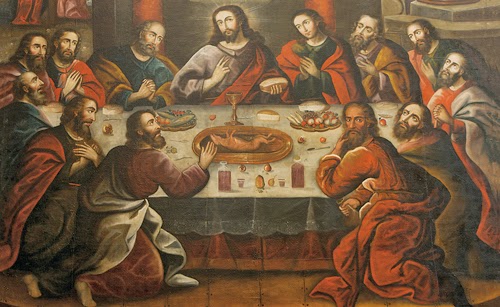
The “Senor de los Temblores,” the Master of Quakes,” is a blackened statue of JC. It is one of the most emblematic symbols of Christianity in Peru today. According to legend, during its journey from Europe to Peru, the ship carrying the statue encountered an horrific storm. Desperate, the crew raised the Christ figure into an upright position and magically the maelstrom passed.
After the earthquake of 1650, the stature became a shrine to the Andean people who placed hundreds of candles beneath it in constant vigil. It is said smoke from the candles turned the “skin” of llama black. Or it might have been a garment of a the Nucchu plant, which were used to cloak the body during special celebrations. The plant would have left its oil on the figure’s skin, trapping the smoke from the flames.
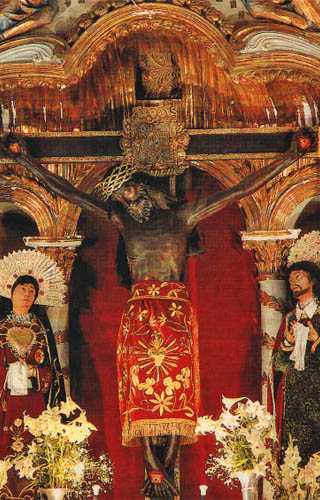
All the madonnas on site, paintings and statues, look like Andre Leon-Talley wannabes. (Or is it the other way around?) They are draped in caftan-like garments covered with symbols of the natural world, so that she takes the shape of a mountain. Mary as Pachamama? It’s everywhere in this country where being “Catholic” means worshipping the Virgin and still celebrating Mother Earth in the old ways. A variation on the theme of a jazz improv.

Sulca Textiles:
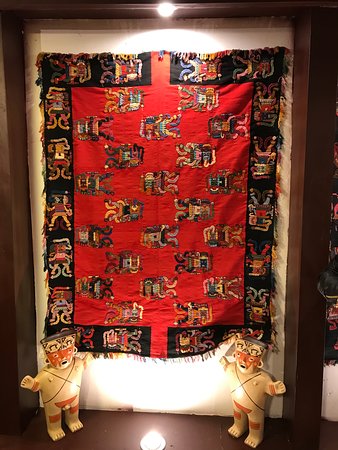
Because we missed the visit to the Huiloc communities, our guide opted for a stop at Sulca Textile, a museum and store where exact replicas of the pieces we saw at Museo Larco in Lima are housed. Like the originals, the tapestries on display are handwoven out of cotton – and nearly as breathtaking as the original textiles, all based on the work of the Paracas, Wari and Incan cultures to name a few. (Yes, they are for sale. And considering the fact they take months, some almost a year, to create, bargains at $2000 – $5000 for wall art.)
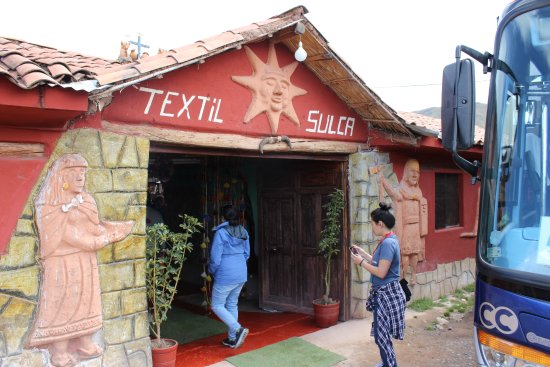
At Sulca, it is also possible to watch the talented weavers in action, making and dying the yarn and creating finished pieces for purchase: alpaca sweaters, accessories and blankets. Caveat emptor: outlets throughout Peru advertise “baby alpaca” goods that are really only “maybe alpaca.” Sulca is guaranteed bona fide. (We went, we saw, we purchased.)
Sol y Luna, foundation first, a resort in support:

Sol y Luna is, like Hotel B in Lima, a Relais & Chateaux property. And like “B,” Kensington Tours arranged for us to stay there in one of a number of well-appointed, casual-chic casitas set against a backdrop of gorgeous flora and fauna (27 horses are stabled at the resort).

Garden at Sol y Luna
But as it turns out, Sol y Luna is not simply about serving well-heeled travelers in the lap of luxury. Not just about creating a picture-perfect campus in the middle of the Sacred Valley.

Our casita at Sol y Luna
At least not primarily.
Net profits go towards a project that is much more important to co-owner and founder Petit Marie Helène Miribel: whatever dollars are left after operating expenses feed Sol y Luna’s real reason for being – the Association Sol y Luna, which supports the Sol y Luna Intercultural School. (Those dollars along with contributions from generous guests and others. Donate here.)
Established just over 20 years ago, the foundation is dedicated to making a difference in young lives through education writ large: classes in math, science and English are part of a curriculum that also includes studies in the original Incan language of Quechua to encourage children enrolled in the school to embrace their culture. The school uses different workshops – theatre, circus, and arts – to build confidence in an unthreatening environment because many of its young people come from alcoholic, abusive homes– or no home at all. Three years ago, Sol y Luna also began taking in young people with special needs. Future plans include building a foster home too. (Some of the kiddos are already living in foster homes, just not a well-planned Sol y Luna residence.)
The institution, which now employs 42 full-time professionals, includes teachers and chefs. It feeds over 200 individuals two meals daily and stays with their students even after graduation to ensure success in life after a formal education.

Petit and a student at the school she and her husband founded.
In his book, “Blessed Unrest,” entrepreneur/philosopher Paul Hawken suggests there is inherent good at the heart of our humanity and the collectively we can – and are – making a difference through entities like small NGOs that are not afraid of hard work and willing to get down in the dirt. “Ms. Petit” as Miribel is known, is one of those individuals and the award-winning Association Sol y Luna is one of those organizations. Her work speaks of enormous love and is having truly positive consequences where she lives.
Twenty-five years ago, Miribel worked as a trader in the mining business in London. Then she was transferred to Lima. Twenty-two years ago, in a white-light moment, she decided to make a life-changing move to the Sacred Valley, where she had never been. Miribel and her architect husband started Association Sol y Luna a few years later. They bought their first land in the late-1990’s and began building out their resort in 2000 on acreage that was once covered with stone. In 2006, guests starting coming, triggering an expansion.
“Over the years our growth has been based entirely on feedback from our guests. We listened when they asked for a second restaurant, a swimming pool, a horse farm and shows of Peruvian Paso horses, more casitas. That’s what we now have in place on the property,” explained Miribel.
The school itself is now 10 years old. Over the 200 students are now enrolled, only 1o of whom are paying full tuition (because they can). Petit’s own kids attend.
“From the start, my husband and I wanted to be useful to other people, to make a difference, so we walked into local schools to offer help. The need was dire. There were classes with no teachers and buildings with no amenities, including toilets. Roofs leaked. Memorization, not thinking was encouraged. Yet what at least one of the teachers asked for were school uniforms. How were uniforms going to help the kids advance in the world? The only way forward was to create our own educational institution and invest in the best teachers we could find.”
A stay at Sol y Luna is a pleasure and a privilege. It is also a stake in the future of a challenged population.


Sorry, the comment form is closed at this time.